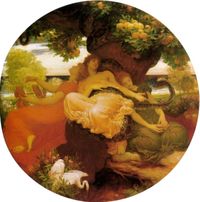
HESPERIDES
these goddesses of evenings and the golden light of sunset were the famous guardians of the golden apples which Ge had given to Hera at her marriage with Zeus. Their names are Aegle, Erytheia, Hestia, and Arethusa, but their descent is not the same in the different traditions; sometimes they are called the daughters of Night or Erebus (Theogony of Hesiod 215), sometimes of Phorcys and Ceto, sometimes of Atlas and Hesperis, whence their names Atlantides or Hesperides, and sometimes of Hesperus, or of Zeus and Themis.

"The Garden of the Hesperides" by Frederick, Lord Leighton, 1892
Instead of the four Hesperides mentioned above, some traditions know only of three, viz. Hespere, Erytheis, and Aegle, or Aegle, Arethusa, and Hesperusa or Hesperia; whereas others mention seven.
The poets describe them as possessed of the power of sweet song.
In the earliest legends, these nymphs are described as living on the river Oceanus, in the extreme west (Theogony of Hesiod 334, but the later attempts to fix their abodes, and the geographical position of their gardens, have led poets and geographers to different parts of Libya, as in the neighbourhood of Gyrene, Mount Atlas, or the islands on the western coast of Libya ( The Aeneid Book IV), or even to the northern extremity of the earth, beyond the wind Boreas, among the Hyperboreans.
In their watch over the golden apples they were assisted or superintended by the dragon Ladon.
